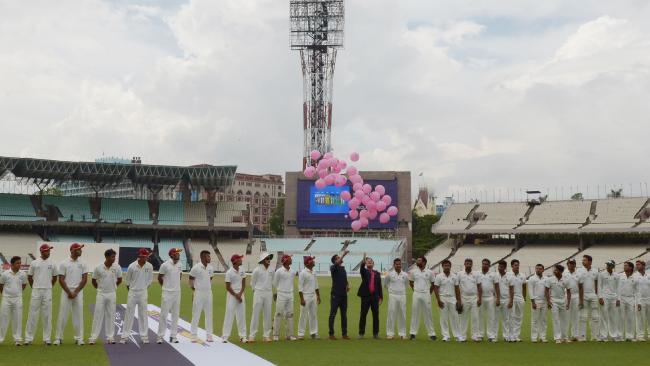Kookaburra and Indian cricket are hailing the first four-day pink-ball trial in Kolkata a success as that country signals an intent to re-embrace the Test match and joins others following Australia’s lead on day-night games.
The latest version of the Australian-made Kookaburra pink ball was used in a four-day Cricket Association of Bengal Super League final between Mohun Bagan and Bhowanipore at the Eden Gardens in Kolkata.
Locals reported that more grass was left on the wicket and around the square of the traditionally dry pitch to protect the ball, but the batsmen and bowlers were happy with the results.
The post-Srinivasan administration at the Board of Control for Cricket in India has shown a renewed interest in Test matches and announced the home side would play 13 Tests on the subcontinent in the next 12 months, including a day-night match.
New Zealand (three), England (five), Australia (four) and Bangladesh (one) are scheduled to play. Steve Smith’s side visits in February-March next year and will play the inaugural Test match at the picturesque Dharamsala stadium in the foothills of the Himalayas.
The BCCI is demanding the host authorities submit plans that make the experience more pleasant for fans, including reserving 10 per cent of tickets for women, children and the disabled and a promise of clean facilities.
Board secretary Anurag Thakara this week said his organisation was also keen to ensure that players earned enough from Tests to ensure they would not be lured away by privatised T20 leagues.
“If we need to keep the players’ interest in Tests alive, we’ll have to ensure that those playing Tests are better paid,” he said this week. “We can’t hide away from the trend which we are witnessing among new cricketers (being more prone towards T20 cricket).”
There has been no decision made on which of the visiting nations will play the day-night Test, but the board was watching the experiment in Kolkata with the Australian ball.
Kookaburra managing director Brett Elliot flew to the venue to witness the trial.
“I was very pleased with the event. The game attracted a great crowd when typically it wouldn’t have,” Elliot told The Australian. “Crowds increased into the evening sessions. The balls were changed at 75 overs (and) still had plenty of shine and firmness.
“We still are working on making sure we get the balance right and are continuing trials on more abrasive pitch conditions. Overall it was a very successful trial.”
Elliot said the grass on the pitch was cut back to 4mm. The grass was left at 11mm in Adelaide for the inaugural pink-ball Test and received criticism because the seaming conditions caused the game to finish inside three days.
The Kolkata trial featured the pink ball with all-black stitching in the seam after players rejected variations on white and green seams from previous matches.
Most Test-playing nations are looking to include day-night cricket in future tours. The West Indies have reportedly agreed in principle to play a day-night Test against Pakistan in the UAE in September. Pakistan is also in talks with Sri Lanka.
Bengal and former Test wicketkeeper Wriddhiman Saha told local papers the pink ball behaved differently. “We took our stance some yards outside the crease in order to counter the swing,” Saha was quoted as saying by Kolkata’s Telegraph. “The ball continued to swing even during the latter stages, which doesn’t happen with a red ball. If you apply yourself against the pink ball and on this kind of a green wicket, you will surely get runs.”
Test bowler Mohammed Shami claimed five wickets and was delighted with the way the ball behaved. “It’s very bright and glows like radium,” Shami said. “With red or white balls, there was some visibility problem as it took (on) the colour of grass. Definitely I will prefer this ball, this is much better. The biggest plus point is (the swing) under lights; what else does a bowler want?
“There was a bit of moisture in the afternoon, so it helped initially. But then, under lights, there was more movement.’’
[Source:- The Australian]




